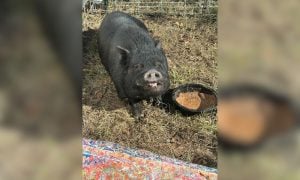The National Park Service (NPS) has installed three new water troughs for rare Tule Elk at Point Reyes National Seashore in California — a move expected to help the survival of the precious species, although other human-caused threats remain.
The troughs are located at White Gulch, the Plateau, and Lower Pierce Ranch, with a fourth anticipated to be installed near Avalis Beach, and will remain through at least summer 2022, according to the NPS announcement.
The agency also installed mineral licks near the water troughs that will provide needed nutrients to the elk. Necropsies of six elk, found emaciated on park lands, showed the animals had suffered from chronic deficiencies in copper and selenium.
This positive development follows a declaration in mid-May from Marin County about emergency drought conditions, with the lowest recorded rainfall reported in the last 140 years, as well as the installation of three, 250-gallon water troughs placed in the southern end of the Reserve. The NPS said the decision to install the troughs was based on those drought conditions, and in collaboration with the California Department of Fish and Wildlife and the Federated Indians of Graton Rancheria.
But the installations also follow unrelenting activism from tireless elk advocates, dubbed “elktivists,” who have repeatedly carried water to the reportedly thirsty animals, despite the NPS then removing those activist-installed troughs.
In Defense of Animals (IDA), an animal welfare nonprofit that has spearheaded elk preservation efforts along with The TreeSpirit Project and FORElk, commended the move.
“We are relieved that the National Park Service has finally turned its efforts to supplying water to trapped Tule elk, rather than dumping out activist-provided troughs,” said Fleur Dawes of In Defense of Animals. “This is a welcome step.”
Jack Gescheidt, founder of the TreeSpirit Project and the elk campaigner for IDA, credited public outcry and citizen action as a major factor in improving conditions for the elk.
“We are thrilled that the NPS has once again buckled to the unrelenting pressure and demands of hundreds of Tule elk activists, and the will of tens of thousands of their citizen supporters,” Gescheidt said. “Providing water for captive animals is a necessary first step by the Park Service and a welcome concession to its responsibilities after years of inaction, denials, and repeated dumping of activist-supplied water deliveries to the dying elk.”
The NPS acknowledged removing the activist-installed troughs, saying the advocates did not work with Point Reyes National Seashore to deliver the water or follow needed precautions.
“Elk advocates did not work with Point Reyes National Seashore in delivering water and did not take precautions described above,” NPS wrote in a frequently-asked-questions section. “Water sources placed by elk advocates at Tomales Point were placed in locations where elk would not typically seek water and did not have escape ramps to avoid accidental drowning by smaller wildlife. The sources of the water and the prior use of water containers was unknown. Some water troughs and other containers were placed in designated wilderness.”
Gescheidt said activists who contacted the National Park Service were told multiple times that adequate water existed within the Reserve. As to the NPS’s other claims, Gescheidt said that activist-installed water troughs did include escape ramps on at least three occasions and that troughs and water put into a dry pond bed were places that elk frequented.
Gescheidt added that recent, controversial NPS decisions — including management decisions that extend leases to ranchers, and also authorize shooting elk outside the Reserve — make a future collaboration unlikely.
“We can’t work with a group that says the cows are not a problem, that is extending 20-year leases to ranchers, and that are shooting elk,” he told Lady Freethinker (LFT). “We’d rather be the activists bringing awareness of these issues to the public.”

A bull Tule elk drinks from a nearly-dried pond in the Tule elk Reserve at Point Reyes National Seashore. (Photo Credit: Jack Gescheidt/TreeSpirit Project.com.)
The elktivists have spent months protesting a 3-mile-long, 8-foot-high fence that constrains close to 300 elk to an enclosed area with poor forage called “The Reserve.” The fence keeps the elk from wandering onto the allotments controversially leased to ranchers.
Gescheidt said the bigger-picture problem of the situation in Point Reyes is the environmental degradation, including water pollution and soil contamination, that accompanies intensive animal agriculture operations.
“Wildlife has been decimated on this continent because of raising cattle, which comes with land degradation, water pollution, and methane emissions,” he said. “The elk are attention grabbing, but it’s not just about the elk. It’s also about national and global issues of climate.”
Miyoko Schinner, the founder of vegan gourmet food company Miyoko’s Creamery and a passionate elk advocate, said the issue boils down to today’s actions becoming tomorrow’s legacy.
“At some point we have to decide: what is the legacy we want to leave?” Schinner said. “Do we want to be the species that exterminated every other species on this planet, which does not belong to just the human species? It belongs to all species, including the Tule elk, and every single species deserves to live.”
The NPS has said it has no plans to reconsider the fence, which was authorized in a management plan from 1998, despite a significant decline in elk.
The federal agency reported the elk population inside the Reserve dropped from 445 elk to 293 elk last year. Free-roaming elk in the Limantour herd saw a slighter decline — from 164 elk down to 155 elk — while the Drakes Beach herd saw an increase of one elk, to a total of 139 elk.
Leading conservationists have noted the main variable with those numbers is the fence that prevents Reserve elk from finding better sources of water and forage.









